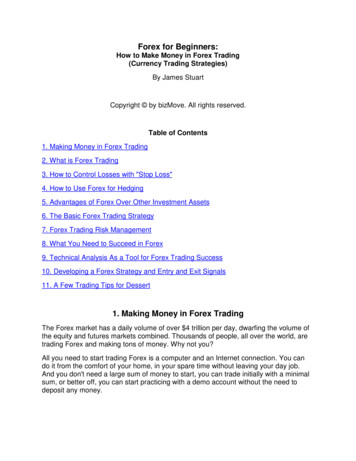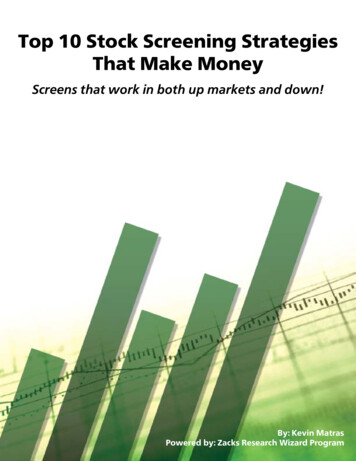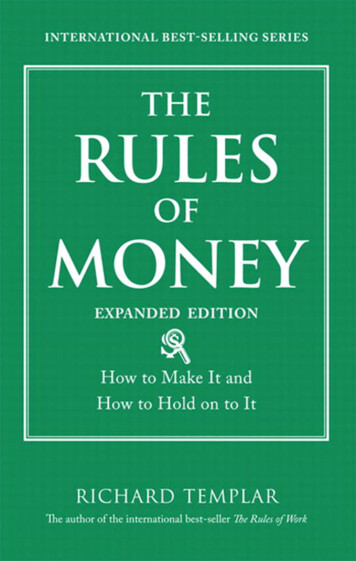
Transcription
How to Make MoneyTrading Part TimeBy Chris PerrunaNYC Trader’s ExpoFebruary 2011
Where to Begin Can you really make money tradingpart time?As a rule, you CAN!HOW ?Let’s findout
Case Study ExamplesMoving Average Reversal Breakout: Buy or Sell?
Introduction Successful Investing through Education Books & Mentors Psychology of Trading & General Rules Essentials of Fundamental Analysis Master Technical Analysis Screening for Stocks Making a Watchlist Money Management Position Sizing Expectancy Case Study Examples
EducationRequired Reading How to Make Money in Stocks (4th edition) by William J. O’Neil (1988) Reminiscences of a Stock Operator by Edwin Lefevre (1923) The Nature of Risk by Justin Mamis (1991) Trader Vic: Methods of a Wall Street Master by Victor Sperandeo (1991) Trade Your Way to Financial Freedom by Van K. Tharp (1999) The Battle for Investment Survival by Gerald M. Loeb (1935) Martin Zweig's Winning on Wall Street by Martin Zweig (1986) How to Trade in Stocks by Jesse Livermore (1940) Market Wizards: Interviews with Top Traders by Jack D. Schwager (1988) When to Sell: Inside Strategies for Stock-Market Profits by Justin Mamis (1994)
"Rule No.1 is never lose money. Rule No.2is never forget rule number one."- Warren Buffett"Profits always take care of themselvesbut losses never do."- Jesse Livermore“You have to learn how to lose; it is moreimportant than learning how to win”
Psychology of Trading General Trading Rules Develop a working SYSTEM Preservation of capital Consistent profitability Cutting losses short Superior returns Understanding “You”: What is your general personality? What influences your decisions? What is your lifestyle?
"If you spend more than 13 minutes analyzingeconomic and market forecasts, you'vewasted 10 minutes."- Peter Lynch“The only function of economic forecasting isto make astrology look respectable”- John Galbraith
Essentials of Fundamental Analysis Earnings Per Share % Change in Latest Quarter’s EPS vs. Same Quarter Prior Year % Increase in Next Year’s EPS Estimate From Prior Year’s Actual EPS Annual % EPS Growth Rate of Last 3 Years Sales/ Revenues % Change Latest Quarter’s Sales vs. Same Quarter Prior Year % Change Latest Reported Fiscal Year Sales vs. Prior Year Annual % Sales Growth Rate of Last 3 Years Relative Price Strength Market Capitalization & Share Price
“Successful traders always follow the line ofleast resistance – follow the trend – thetrend is your friend”- Jesse Livermore“In order of importance to me are: (1) the longterm trend, (2) the current chart pattern and(3) picking a good spot to buy and sell.”- Ed Seykota
Master Technical Analysis Candlestick Charts Weekly Charts Daily Charts What to Look for: Properly Forming BasesMajor Moving AveragesVolume, Volume, VolumePivot PointsBreakout Areas Point and Figure Charts New Highs vs. New Lows Ratio
Candlestick ChartsDaily ChartWeekly Chart
Point & Figure ChartsIndividual StocksGeneral Market
New High – New Low Ratio2009 Turning Point2003 Turning Point
Screening for Stocks Quality Stocks making New 52-week Highs Quality Stocks with a new IPO within the past two Institutional Sponsorship Increasing Quality Stocks that are trading within 15% of 52-weekHighs Quality Stocks within 10% of the 200-day MovingAverageQuality: Earnings Per Share (EPS) Rating: From 60 to 99 Relative Price Strength (RS) Rating: From 60 to 99
Screening for StocksSample Screen – New Highs
Screening for StocksSample Screen – IPO’s
Making a Watchlist Key selection criteria: Filter stocks up 1% or more Volume greater than average by at least 50% Seek stocks that are making multiple screens Technical criteria: Identify trend (up or down) Recognize base Identify pivot point or breakout area Establish support and resistance levels
Case Study ExamplesMoving Average Reversal Breakout: Buy or Sell?
Money Management Position Sizing: Understand “how much” money to trade on each position Know account size & available funds Determine maximum risk per position Expectancy: How much to make (win or lose) for every dollar risked? How many trades - how much opportunity? Expectancy (Probability of Win * Average Win) – (Probabilityof Loss * Average Loss) (0.4 * 2,500) – (0.6 * 625) 1,000 - 375 625 per trade (40% * 20%) – (60% * 5%) 5.00%– 100k account, 12,500 per position or 1% risk:– Win 40% of time, 20% ave gain, 5% ave loss
Manage Risk w/ Position Size“The golden rule of trading is to keep losses at a level of 1 R as often aspossible and to make profits that are high-R multiples.” - Van K. Tharp
“A trading philosophy is something thatcannot just be transferred from one personto another; it’s something that you have toacquire yourself through time and effort”- Richard Driehaus“The way to build long-term returns isthrough preservation of capital and homeruns”- Stanley Druckenmiller
Case Study ExamplesMoving Average Reversal: Buy or Sell?
Case Study ExamplesMoving Average Violation: Buy or Sell?
Case Study ExamplesHigher Highs and MA Support: Buy, Hold or Sell?
Case Study ExamplesMoving Average Violation: Buy, Hold or Sell?
In Closing Trading Rules to Live by: Cut Losses Ride Winners Keep bets small and manage risk Follow the rules without question (your proven system)“The elements of good trading are: (1) cutting losses, (2) cuttinglosses and (3) cutting losses. If you can follow these three rules,you may have a chance.”Hat tip: Ed Seykotavia Market Wizards
Trading Rules to Live by: Cut Losses Ride Winners Keep bets small and manage risk Follow the rules without question (your proven system) Hat tip: Ed Seykota via Market Wizards “The elements of good trading are: (1) cutting losses, (2) cutting losses and











